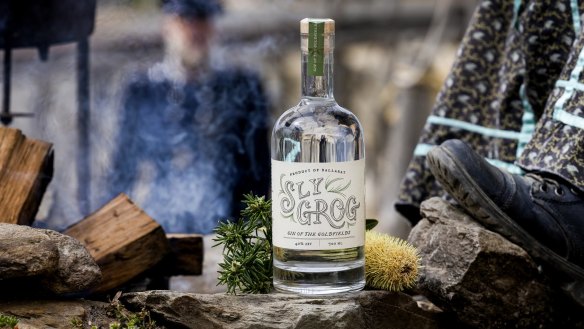180 years later, Ballarat's sly grog comes clean

Polly O'Shea may be a fictional character, but that didn't stop the team at Ballarat's Sovereign Hill making a gin in her honour.
For several years, the Ballarat gold rush-era living museum's chief development officer, Will Flamsteed, had been toying with the idea of distilling a gin which could help tell the story of women in the Victorian goldfields of the 19th century.
Many of them earned a living doing anything to make ends meet – including selling illicit alcohol.
"Polly O'Shea is an archetype," says Flamsteed. "She is portrayed here at Sovereign Hill working from her tent. We based her character on accounts of women who worked on the goldfields offering hospitality in very inhospitable conditions.
"They would pitch a canvas tent and offer stews, tea and coffee. Out the back, they would offer alcohol."
At the time of the gold rush in the 1850s, the sale of liquor was illegal and demand from thirsty miners was immense.
"The colonial government felt that the goldfields were chaotic enough without the addition of alcohol to fuel the situation," says Sovereign Hill historian Anna Kyi.
"There was not one, but seven different police forces, so there was no cohesive force overseeing the fields. Add to this the lack of potable water on the goldfields, and a predominantly young and male workforce saw that government prohibition was ignored."
Some spirits were smuggled up from the port at Geelong. When they arrived at the goldfields they were watered down and adulterated with spices, opium and tobacco.
One drink popular at the time was called Blow My Skull Off, a rather toxic and intoxicating mix of rum, brandy, Turkish opium, cayenne pepper and the seeds of an Indian creeper that were also used to stun fish.
"We also understand that there was some illicit distilling taking place on the goldfields," says Flamsteed.
Making a gin to celebrate the sly grog sellers was undertaken by Ballarat couple Chris Pratt and Rebecca Mathews from Kilderkin Distillery.
"We had a brief from Sovereign Hill to make a gin using the botanicals that would have been available on the goldfields during the 1850s," says Pratt. The pair started with juniper, gin's essential ingredient.
"The Chinese miners would have had juniper on the goldfields," he says.
Kilderkin Distillery also looked to Indigenous plants of the goldfields and used the flowers of the silver banksia, a bloom used to make sweet drinks by the Wadawurrung people long before gold was discovered in the region.
Native plants such as cinnamon myrtle and pepperberry were also included in the mix. From Sovereign Hill, Pratt and Mathews picked rosemary which grows prolifically on the site.
All the botanicals were steeped in alcohol vapours to extract the aromatic compounds and the result is Sly Grog Gin, an easy drinking spirit with resinous and floral notes.
It's now served at the bar of the US Hotel inside Sovereign Hill with a dash of tonic, or can be purchased through the living museum's website for $85 a bottle, and Campana's Cellar and Deli in Ballarat.
"This is a fundraiser," says Flamsteed. "All profits will be ploughed back into Sovereign Hill."
